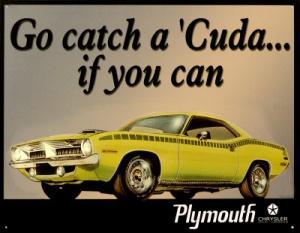Barracuda
In 1964, Plymouth created a sportier version of their compact/economy Valiant at about the same time as Ford created the sportier Mustang from their compact economy Falcon. These became to be known as Pony Cars.
This Wiki is well underway, but can still use your help!
Please take a moment to add any small amount of information that you might have on this topic. It is through this type of collaboration that the MoparWiki will grow into being the Ultimate Mopar Infobase. Please fill in any missing information you know to be factual. Correct any you know to be inaccurate.
Contents
History:
In 1964, the Barracuda was created to go after the youth market, with the base for it being the Plymouth Valiant. Initially it was essentially the same car as the Valiant, but with an extreme fastback roof. It competed with the Ford Mustang, which was a sportier car created from the mundane Falcon. A few years later Chevrolet introduced the Camaro, and Pontiac the Firebird to complete with the Mustang and Barracuda. These were referred to as Pony Cars. These cars quickly gained small block V8s as the Muscle Cars became big sellers with American youth, and they started to distance themselves from their humble economy car beginnings.
With the Horse Power Wars heating up in the late 60s, car manufacturers were trying to stuff big block engines into these cars, which was a real struggle with the A-Body Barracuda. For drag racing, the Barracuda and its sister car the Dodge Dart shoehorned 426ci Hemis into the engine bay in 1968-1968, for a limited number handed out to a select few big name racers. These cars were not street legal, but still hold NHRA records today. For the street Barracudas, a 440 was shoehorned into a limited number of Barracudas in 1969, and called the Cuda. 1969 was the last year for the Barracuda/Cuda to be on the A-Body Platform
In 1970, the Barracuda debuted on the E-Body platform, which was essentially a shortened B-Body. It made it much easier to place big block engines, including the Hemi, in the cars. 1970 and 1971 big blocks are the most collectible of the Barracudas/Cudas. In 1972, the insurance companies and the Government had all but killed the muscle car -- and smog emission and lower compression reduced power. The last few years the Barracuda didn't even offer a big block, and in 1974 the last Barracuda rolled off the assembly line.
Model Predecessor
Model Successor
None
Export Versions
Related Models
- Dart GT
- Dodge Dart GTS
- Dodge Challenger
Competition
- Ford Mustang
- Chevrolet Camaro
- Pontiac Firebird
- Dodge Dart GTS
- Dodge Challenger
Body Styles
Technical:
Class
Pony Car
Platform
Engines
Transmissions
Specifications:
Length
- 1964-1965, 188.2 inches
- 1966, 188.3 inches
- 1967-1969, 192.8 inches
- 1970, 186.7 inches
- 1971-72, 186.6 inches
- 1973, 193 inches
- 1974, 195.6
width, height,
wheelbase
- 1964-1966, 106 inches
- 1967-1974, 108 inches
Year by Year Changes, Production Numbers, and Cost:
1964
1965
Engine
The standard engine in 1965 was a 225 cubic inch Slant Six rated at 145 horsepower. Two V8 engines from Chrysler's LA-Series were also available as options. One could either get a two-barrel carbured 273 cubic inch engine that produced 180 horsepower and 260 lbs-ft. of torque or the Commando 273 rated at 235 horsepower. The Commando 273 was available through the Rallye Pack option and or the Formula S package and contained a four barrel carburetor.
Transmission
The standard transmission was a three speeed manual. Optional transmissions were either a console-shifted Torqueflite Automatic or a floor-mounted four-speed manual transmission which had Hurst linkage.
1966
1967
1968
1969
1970
1971
1972
1973
1974
Wiki Topic References:
Magazine References:
- Hemmings Motor News September 2010 page 14

